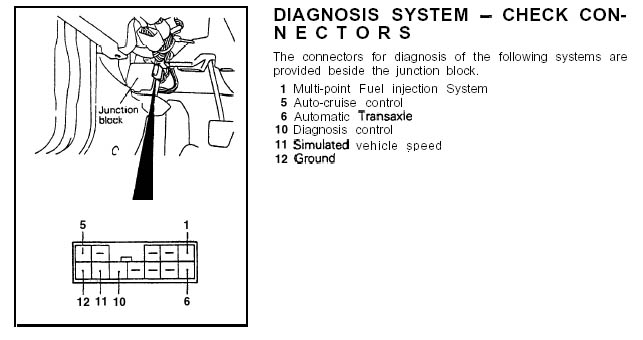89-90
SELF-DIAGNOSIS AND INPUT-CHECK FUNCTIONS
SELF-DIAGNOSISWhen there is a cancellation of the auto-cruise control system operation not intentionally made by the driver, it is possible to determine which circuit or what operation caused the cancellation of the auto-cruise control system by following procedures,

Stop the vehicle with the ignition switch and MAIN switch in the ON position.
NOTE Turning OFF either the ignition switch or MAIN switch erases the diagnosis data. Be sure to keep the ignition switch and MAIN switch in the ON position until you finish the inspection.
| Code |
Probable cause |
| 11 |
Abnormal condition of actuator clutch coil drive
system |
| 12 |
Abnormal condition of vehicle speed signal system |
| 13 |
Low-speed limiter activation (The system is normal if it can be reset.) |
| 14 |
Automatic cancellation activated by vehicle speed
reduction (The system is normal if it can be reset.) |
| 15* |
Control switch malfunction (when SET and RESUME
switches switched ON simultaneously) |
| 16* |
Cancel switch ON signal input (stop light switch,
clutch switch or inhibitor switch input wiring damage or disconnection
or occurrence of abnormality in circuit within control unit.) |
1. Codes indicated by the * symbol are displayed, if the conditions are satisfied, even if the system is normal. In either case, the system is normal if it can be reset.
2. Diagnosis codes are displayed when, after cancellation of the auto-cruise control system, the vehicle speed decreases
to less than approximately 20 km/h (12 mph), and are erased by switching OFF the ignition switch or the MAIN switch.
3. After the diagnosis codes in the memory are erased, if (when the power supply of the electronic control unit is switched ON once again) the power supply of the electronic control unit is normal, continuous ON/OFF signals will be displayed at 0.5 second intervals, regardless of whether the system condition is normal or not.
INPUT-CHECK FUNCTION
The input-check function allows you to check if the input signal is normal when a cruise control failure occurs, including the situation where the cruise control cannot be set.
(1) Connect a voltmeter to the diagnosis connector of the junction block.
(2) Operate the SET and RESUME switches simultaneously.
(3) Turn ON the ignition switch; the input check can now be carried out. Perform the corresponding input operations to read the output codes.
| Code |
Input operation |
Check results |
| 21 |
SET switch ON |
SET switch circuit is normal. |
| 22 |
RESUME switch ON |
RESUME switch circuit is normal. |
| 23 |
Each cancel switch ON 1. Stop light switch (brake pedal depressed) 2. Clutch switch (clutch pedal depressed) 3. Inhibitor switch ON (shift lever to “N” position) |
Each cancel switch circuit is normal. |
| 24 |
Driving at approx. 40 km/h (25 mph) or higher |
When both Code 24 and Code 25 can be confirmed,
vehicle speed sensor circuit is operating normal. |
| 25 |
Driving at less than approx. 40 km/h (25 mph).
or stopped |
1. If two or more input operations are performed at the same time and the microcomputer receives the corresponding signals, their output codes are indicated repeatedly in code number order as long as the corresponding signals are input.
2. If the input operation is canceled while the output code is being indicated, the code continued to be indicated until it completes a display cycle. If the code does not disappear, the switch or harness is probably defective.